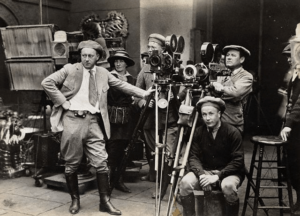Lately I have been stepping back more from the film industry to try and understand as much as possible all the light speed changes, forces, and issues at work for 21st century filmmakers. And how best to approach them. Many affect all filmmakers, whether indie or studio. However, nowadays when attempting to discuss or write about the current state of the film business, it’s quite a bit like hitting multiple moving targets. But hey, let’s take a swing at it, OK?
Yes, the film industry in late 2016 is an ongoing complex labyrinth of technological interchangeable pieces, competing perspectives and worldviews, and constantly evolving tactics and strategies, always shifting at progressively faster velocities. So for everyone’s sake, please remember that the following is IMHO-ATPIT-ASTC (In My Humble Opinion – At This Point In Time – Always Subject To Change). Don’t you just love this alphabet soup of acronyms spilling out into our modern twitter-ized hashtag world?
So, how about we break all this down into three separate sections; Film Development & Production, Film Marketing & Distribution, Film Exhibition & Audience. Of course, there will always be some overlap here, but for the sake of educational focus and clarity let’s try to simplify it as much as possible. This whole thing is already almost too damn complex to communicate effectively anyway.

How do we make this now?
Development & Production
For the most it does seem obvious the general public is quite aware now that the means of production of the modern film has changed drastically the last couple decades. In fact, calling them films actually seems retro now, because who makes films out of film anymore? Myself, I haven’t seem a piece of celluloid in quite a while. Maybe we should call them Digitals, or DigiFlicks? Or 0’s & 1’s, or Videos (nah, that’s so yesterday), or maybe just back to Movies, since that’s probably what they were called in the first place?
But actually, this is still ongoing and changing. Films are now being made with digital still cameras, tablets, and mobile phones, and with continuing advances of newer digital cinema cameras shooting in 3D, 4K and even 8K, and of course, VR (virtual reality) and VFX (visual effects) tools. Anything that can capture a moving image, huh? Hey, if a toilet seat or refrigerator could do that, we’d use it, right? And now we have drones flying around everywhere, filming cool moving angles and scenes. Moving being the operative word here. Pretty much most images now are always moving. Rarely do subjects (actors) within a still frame move around within a well-though out, well-designed, and well-framed space. No, now the subjects and the scene space have to all be on the move, all the time. We have to keep that kinetic energy moving and speeding somewhere away from where we may be in any one moment. Because these still, designed moments, are so yesterday. Cameras have to always be moving now, since there is no time for contemplation and reflection for our attention deficit runaway media. The director doesn’t yell ‘Action!’ for nothing, right? Action, baby!
As far as the development process, we now have lots of digital tools, software and apps, at our disposal for writing scripts, creating storyboards, pre-visualizing shots (pre-viz), shot lists, schedules, and on and on, etc. And the casting process has been greatly facilitated with online demo reels and live streaming of casting sessions, so directors and actors never had to meet unless they are chosen for their roles. A new trend developing in casting involves social media. Actors who have the most fans are now considered more favorably for their parts, since they have a known fan base ready and waiting. Yes, the marketing people have their hands in this, but that is nothing new. All these (and more) wonderfully exciting gizmos break down and expedite the development and pre-production process for the modern filmmaker, no matter whether indie or studio.
And don’t even get me going on post-production tools and workflows. I can’t keep abreast of all the new digital software and hardware combos available, for not just the mainstay of editing, but color correction, visual effects, green screen, motion capture, time lapse, sound mixing and effects, stock footage houses, online collaboration, etc. Granted some of these overlap from production, but you have to deal with all this in post. Yikes, my head is gonna explode!
Granted the 21st filmmaker has so many more tools at their disposal, work processes to consider and use, and mores skill sets they must learn and incorporate, but are they better filmmakers? Has any of this has resulted in better films? Is the main reason of storytelling still intact and/or evolving? Well, it certainly has increased the number of films being produced, as it’s estimated that about 50,000 films are now made annually in the U.S. Certainly the entry barriers for filmmakers have pretty much fallen and been stripped away. However, most of those films are never ever seen, as they are low budget indies with little future since traditional distributors and studios are picking up fewer of them every year.
There are just two other areas I will touch on here briefly before I move on; video games and finance. Video gaming has grown into an immense industry, and one I am not as well-versed in as the filmmaking one. However, filmmakers have been taking advantage of the technological advances in the gaming world more and more, but that world still suffers in relation to the more developed story world of filmmaking. But it seems there are possibilities on the horizon for game creators and filmmakers to collaborate in several ways to co-release films and games built on the same storylines and content. I would bet that there are some untapped opportunities here, which could redefine the future for both industries.
And now the $$$. As always, it usually comes down to the bucks when trying to make a film. And most indie filmmakers don’t have access to much of that. Aside from begging on the streets or conning a rich uncle, there are few choices here. Crowdfunding has been one of the big buzzwords the last few years, but realistically most films never get sufficient funds to ever reach the production phase. To make matters worse, the tax breaks of a few years ago have gone away, and some states are even pulling their incentives to film in their neck of the woods. And many of those 50,000 films just mentioned are usually made for just a few thousand dollars from the filmmaker’s and a few close friends’ pockets. And that is the one choice for passionate filmmakers who will not take no for answer.
The only other one for most of us is to go back to a tried and true old school method, of rounding up our personal contacts, friends, and relatives, and see if we can scrounge up someone or a couple someone’s who have enough extra spare change to grease those production wheels. I’m talking about at the very least $200K, but preferably $500K, and better up to $1M. That is certainly serious dough for most of us, but I truly think it takes that to grind out a decent film in today’s world. There are some exceptions, but most films made for under $200K don’t live up to most audiences’ quality expectations.
C’mon, someone you know knows someone or several someone’s who can put this kind of money on the table together. Yes, really, I’m serious. You will need to put your entrepreneurial hat on, but that is required for filmmakers. That’s right, indie filmmakers must now (for a while now) be entrepreneurs if they want their films to live beyond the edit suite and film festival circuit. Which takes us to …

How do we get this out there now?
Marketing & Distribution
This world has changed drastically in the last decade or so, creating on one hand a more accessible path for the indie filmmaker, yet on the other one a much more complex labyrinth to navigate.
Studios are becoming more entrenched in the tent pole popcorn film franchises; comic book movies, endless sequels, and more reboots. The executives, not the filmmakers, have been calling the shots in that world for a while, which has resulted in a progressively downward trend in story originality, variety, and quality, along with audience fatigue overloaded with all this sameness. And take into account the exploding competition from China that is starting to affect the domestic industry here, in which it is predicted that they will overtake U.S. box office by next year. Yes, China is gearing up to be a major player in the worldwide film industry, which is making Hollywood quite uneasy. Other countries are also on the edge of lining up to compete directly with us.
As already mentioned the indie film market is over saturated with content, and even filmmakers. Most films are either of this low budget variety or the big budget studio extravaganzas. Meaning that the medium budget films have been disappearing, or are moving down in the food chain into the lower budget arena or up the food chain to the big league studio distributors.
Distribution windows are completely out of whack now, or do they even exist anymore? There had been an agreed upon exploitation sequence for quite a while now. But since consumers are now demanding to watch films or any other media content anywhere at any time, there is more pressure on distributors down the pipeline to collapse that pipeline. Expect to see more fall out within the industry over this in the near future, as Netflix and Amazon have been a couple drivers of this change. So now about anyone can watch a film at the theater, on Blu-Ray, or streaming online at the very same time. And if they don’t want to pay, there is still piracy.
Yes, piracy is still a big issue, as billions is lost every year. Although mostly studio films are affected, indies can also take a serious hit. But there are differing points of view. Some feel that such free exposure for indies can help then build a fan base for future projects and/or charge for extra merchandise beyond the film. Others feel it devalues their film, and reduces their inventive to create more films. ISP’s (Internet Service Providers) probably have the upper hand in this, in how well they monitor pirated content streaming off their hosted websites, or in responding to filmmakers’ complaints. This problem is far from being resolved in any meaningful way, partially because of the international element of the problem.
This leads us to the magic new world of VOD (video on demand), whether it be transactional, subscription or ad-supported, and the instant streaming and download of almost any media content at any time. The much heralded potentials from years ago of what the Internet could deliver has now finally arrived. However, VOD is now shaking up the cable world, resulting in more industry fallout if alliances are not shored up in that arena. But hey, let all the big guys duke that all out. The problem for indies will be elsewhere.
Now, with no barriers to the distribution of content one of the consequences is the great abundance of such content, to where the task is trying to find what you’re looking for. And this is the great challenge now facing indie filmmakers. How in the hell is anyone going to find my little niche film? Even if I have it playing on a dozen different online platforms, it will be lost in the noise of thousands and tens of thousands of other films. Many of which will be theatrical studio films with massive advertising budgets. How will it rise up and be noticed?
Are we going to need new marketing models to keep up with the big guys? Or will the big guys eventually crush us all? Since the chances are good that most of our films will never get picked up by any distributors, we now have to use online aggregators or self-distribute. And as far as the marketing part we are mostly relegated to using social media, websites, email lists, affiliate partnerships, and more one on one engagements to building audiences, communicating with them, and creating content they desire. Which isn’t to say those aren’t great tools, but they do require a lot more work for understaffed indie film operations. This leads us now to …

Who’s going to watch this now?
Exhibition & Audience
Obviously distribution and exhibition are interconnected and just different sides of that same coin, as sometimes the distributor and exhibitor are the same business entity. For the most part studios have been producing fewer films overall, as revenues and theater averages have been gradually sliding for years. With an overabundance of films and other media choices, the theatrical box office is in trouble. Theaters are trying to reinvent themselves, because they have no other choice, if they don’t want to closer their doors. Theaters must evolve or become extinct.
The holy grail of this theatrical exhibition for indies is practically non-existent. Unless you can utilize service oriented deals with indie arthouse theaters, or create a movie event by congregating that audience you have been attempting to build through social media and email, or even having a service like Tugg crowdsource those community screenings for you. Part of the problem here is the many or the arthouses and mom and pop theater operations are disappearing across the cinema landscape.
One of the solution for some filmmakers has been to create online communities around their films, based on the subject matter that interests that particular audience. This enables them to interact with them at some level, continue a dialogue about future content, and get feedback from their audiences. And maybe even add voices to the development of future projects from that audience, and to then share that with their friends.
Oddly enough, this brave new world of film creation, distribution, and exhibition has morphed into a world where feature films are no longer the dominant option for leisure activity. With so many other types of recreation, and other media content choices, feature films as we have known them in the past, no longer get the public’s attention like they used to. Plus, it seems audiences today are more distracted and overwhelmed by all these choices, but it has become a buyer’s market with all these choices and usually at a lower price. But is that enough?
So, what do these film audiences want and need … today? Entertainment used to be enough, but well before that first 100 years rolled by, the fascination for the novelty of film had worn off. Audiences do demand more. They still want solid well-executed stories, but they want to feel something real, complex and layered, not contrived, manipulative and shallow. How about leading us to a place where we can understand or comprehend something or someone, or even ourselves, better? Making us think instead of just emote inside melodrama jail. Getting us there can then more easily set us up for the transformative experience many of us desire. Films certainly won’t create our own burning bush, but maybe set us on a path to consider the possibilities? Yes, it seems that movies are more than entertainment now. They can have an effect on us and the world, and maybe even change us or the world. The future for film? It must evolve or it will become obsolete and be replaced by something else with loftier and deeper purposes than shilling empty product, eye candied merchandise, or manipulative emotive experiences.
Indie filmmakers have more opportunities, along with more challenges, than they ever have. It will be intriguing to see where this all goes. And to see how each filmmaker responds to the question … why make films … now?
JAD
Author: Jerry Alden Deal
Writer – Director – Producer of Way To Go Media, LLC.
Over the past thirty years Jerry has been hired numerous times to develop and write screenplays for other production companies. During that same period several of his spec scripts were also optioned. ‘Dreams Awake’ was Jerry’s feature directorial debut. He has several other projects in various stages of development. One of which, the feature documentary ‘The Inner Sonic Key’ is currently in post-production.
